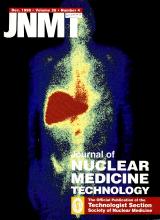Abstract
Objective: We compared the count ratios of 201TI and 99mTc on SPECT images and the true radioactivity in a myocardial phantom to study how precisely SPECT images reflect tracer uptake in myocardial infarction.
Methods: A defect with 20%, 40% or 60% of normal myocardial radioactivity was placed in the anterior or inferior wall of a myocardial phantom to simulate myocardial infarction. Lung radioactivity was kept at 10% or 30% of normal myocardial radioactivity. The count ratio on short-axis SPECT images was calculated using the circumferential profile curve analysis.
Results: The count ratios of 201TI and 99mTc SPECT images with an anterior wall defect was lower than the true radioactivity in the phantom. The count ratio on SPECT images with the inferior wall defect was greater than the true radioactivity for the 20% and 40% defects and lower for the 60% defect.
Conclusion: SPECT images overestimated decreased perfusion in the anterior wall. SPECT images underestimated decreased perfusion for 20% and 40% perfusion defects in the inferior wall.







